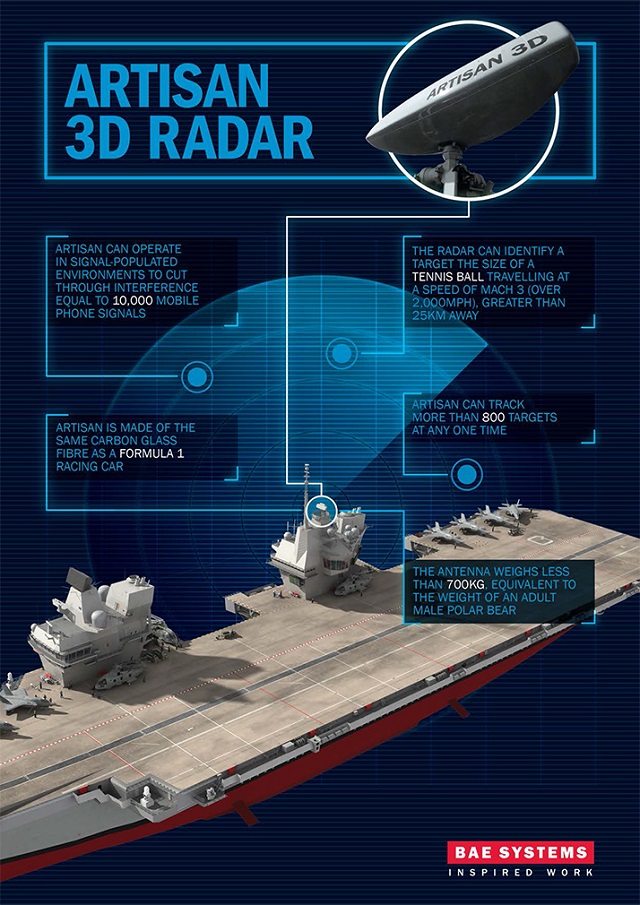U.K. Aircraft Carrier Fitted with First-of-Kind Radar
A cutting-edge 3D radar system, capable of detecting objects as small as a tennis ball and travelling at three times the speed of sound more than 25 kilometers (82,000 feet) away, has been successfully installed on the U.K. Royal Navy’s future aircraft carrier HMS Queen Elizabeth.
Known as Artisan 3D the radar system will be used for the first time to deliver air traffic management, providing the aircraft carriers with unparalleled awareness and control of the skies around them.
The system, designed and developed by BAE Systems, can monitor more than 800 objects simultaneously from 200 meters (650 feet) to 200,000 meters (656,000 feet) and cut through radio interference equal to 10,000 mobile phone signals. The radar system has already proven its capability to deliver uncompromising air defence and anti-ship operations on the Type 23 frigate and helicopter carrier.
Les Gregory, Director for Products and Training Services at BAE Systems said: “Artisan is a ground-breaking radar system that delivers real capability to the Royal Navy in its supreme accuracy and uncompromising tracking. In addition, its world-leading electronic protection measure ensures that even the most complex of jammers will not reduce its effectiveness. We have already seen the radar perform excellently on the Type 23 frigates and are proud to be able to bring this advanced technology to the Royal Navy’s new aircraft carriers utilising its air traffic management capability for the first time.”
The new aircraft carrier will become the flagship of the Royal Navy and demand the best radar technology to deliver uncompromising carrier strike capability anywhere in the world. The carriers will also be versatile enough to be used for operations ranging from supporting war efforts to providing humanitarian aid and disaster relief.
Preparations to install the radar system on to HMS Queen Elizabeth have taken two and a half years. Part of this work included creating a life-sized mock-up of the carriers’ aft island which was used to hone the radar’s interaction with the combat systems on board the Queen Elizabeth.
As the largest ship ever built for the Royal Navy, the aircraft carrier:
• Has a height of 56 meters (184 feet), taller than Niagara Falls;
• Has a length of 280 meters (920 feet) with a flight deck the size of 60 tennis courts;
• Has a 70 meter (230 feet) wide deck that could fit four jumbo jets alongside each other;
• Has a range of 10,000 nautical miles and carries enough fuel to transport a family car to the moon and back twelve times.
Operating with Lightning II fifth generation stealth Joint Strike Fighter jets, the QE Class will be versatile enough to be used in a full range of military tasks from warfighting to providing humanitarian aid and disaster relief.
Following sea trials (from 2017) and First of Class Flying Trials for helicopters and the F-35B Lightning II (starting in 2018), HMS Queen Elizabeth will undertake a coherent build up towards achieving an Initial Carrier Strike Capability in 2020.
The second of class vessel HMS Prince Of Wales is expected to be operational in 2023.

that matters most
Get the latest maritime news delivered to your inbox daily.
The aircraft carriers HMS Queen Elizabeth and HMS Prince Of Wales are being delivered by the Aircraft Carrier Alliance, a unique partnering relationship between BAE Systems, Thales UK, Babcock and the U.K. Ministry of Defence.

